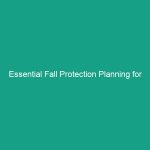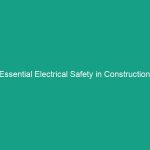Good Morning Team!
Today, we are going to talk about a crucial aspect of our Workplace Safety: protective footwear. This talk is designed to ensure that each of you understands the different types of protective footwear available, the Hazards they protect against, and the importance of wearing the right footwear for your tasks.
Understanding and utilizing the correct protective footwear can significantly reduce workplace injuries, enhance comfort, and increase productivity. Let’s dive into the must-know protective footwear types and the guidelines that will lead us toward Safety success!
Understanding Protective Footwear
Protective footwear refers to shoes or boots that are designed to safeguard the feet from various workplace Hazards. These hazards can range from heavy falling objects to slippery surfaces, Electrical Hazards, and more. Wearing appropriate footwear is not just a personal choice; it’s a critical Safety measure that impacts your daily operations and overall well-being.
Many employees might think that wearing regular shoes is sufficient for work environments. However, this misconception can lead to serious accidents and injuries. Knowing the types of protective footwear available and their specific functions is essential for your safety on the job.
Key Hazards, Risks, and Safety Considerations
Let’s discuss some common hazards that protective footwear can help mitigate:
- Heavy Objects: In environments where heavy items are moved, the risk of dropping something on your foot is high. Steel-toed boots are designed to protect against such impacts.
- Slips and Falls: Wet or uneven surfaces can cause slips and falls. Slip-resistant footwear can significantly reduce this risk.
- Electrical Hazards: In electrical work, non-conductive footwear can prevent electrical shock. It’s crucial to wear the right type of shoes in these settings.
- Cut and Puncture Risks: Sharp objects on the ground can puncture regular shoes. Protective footwear with reinforced soles can prevent these injuries.
The consequences of ignoring these risks can be severe, ranging from minor injuries to life-altering incidents. Therefore, it is essential to take footwear safety seriously.
Best Practices, Procedures, & Actionable Advice
Here are some Best Practices to ensure you are wearing the right protective footwear:
- Assess Your Environment: Before selecting your footwear, evaluate the specific hazards present in your work area. Do you need steel-toed boots, or is slip resistance more critical?
- Choose the Right Fit: Properly fitting footwear is crucial. Shoes that are too tight can cause discomfort, while loose shoes can lead to tripping.
- Inspect Your Footwear: Regularly check your shoes for signs of wear and tear. Replace any damaged footwear immediately to maintain safety Standards.
- Follow Company Policies: Always adhere to your company’s safety policies regarding footwear. These policies are in place for your protection.
For example, in a previous incident at a warehouse, an employee sustained a severe injury due to wearing inadequate footwear while handling heavy materials. This incident could have been avoided had the employee chosen appropriate protective footwear.
Regulations, Standards, and Compliance
Compliance with safety standards is non-negotiable. In the United States, the Occupational Safety and Health Administration (OSHA) provides guidelines for protective footwear. According to osha standards, employers are required to ensure that employees wear appropriate footwear where there is a risk of foot injuries.
Understanding these Regulations is critical not only for compliance but also for fostering a culture of safety. Non-compliance can lead to severe penalties for employers and unsafe environments for employees.
Employee Engagement & Discussion
Now, let’s open the floor to discussion. Think about the footwear you currently wear:
- What challenges have you faced regarding your footwear on the job?
- Can you share any experiences where the right footwear made a difference in your safety?
Your feedback is invaluable as we strive to create a safer workplace. Remember, safety is a collective responsibility!
Conclusion & Key Takeaways
In conclusion, understanding the different types of protective footwear and adhering to Safety Guidelines is essential for your well-being on the job. Remember these key takeaways:
- Identify the hazards in your work environment.
- Select appropriate footwear that meets your safety needs.
- Regularly inspect and maintain your footwear.
- Follow company safety policies and guidelines.
Thank you for your attention and commitment to safety. By prioritizing protective footwear, we can help ensure a safer working environment for everyone. Let’s step forward together towards safety success!


